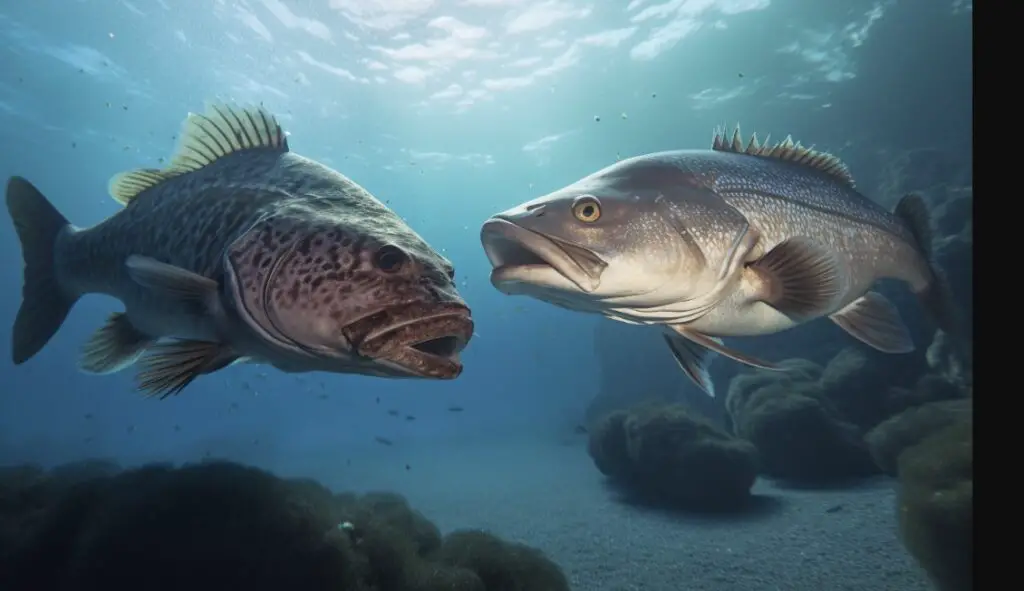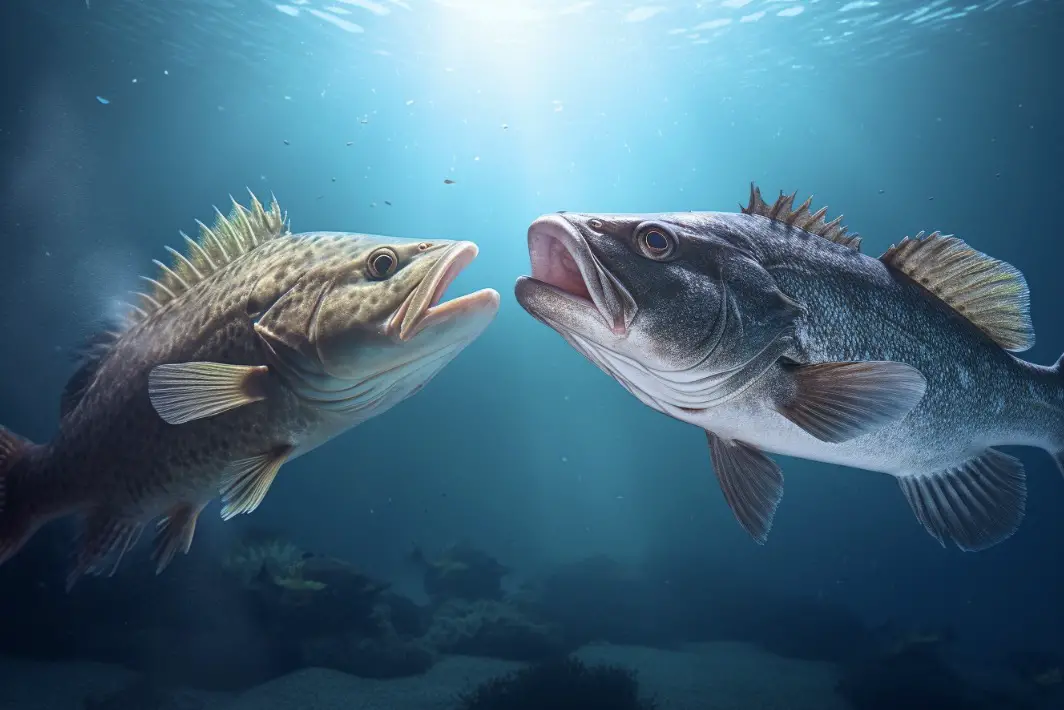The main difference between sea bass and grouper is that sea bass are smaller, more slender fish with a wide range of habitats and variety of species, while groupers are generally larger, stockier fish that are mostly found in coral reefs.
Both sea bass and grouper are fascinating and ecologically important marine organisms that play an essential role in maintaining healthy ocean ecosystems.
As a marine biologist, I have been fortunate enough to study and observe these species in their natural environment, and have discovered many intriguing aspects about their biology and behavior. In this blog post, we will take a closer look at sea bass vs grouper and explore their differences, similarities, and ecological roles.
Contents
Sea Bass: An Overview
Biology and Morphology
Sea bass is a common name that can refer to a wide variety of fish species belonging to different families, including Serranidae, Moronidae, and Latidae. While there is considerable variation among these species, they generally share a few common features. Sea bass are typically smaller and more slender than grouper, with elongated bodies, large mouths, and sharp teeth. They are generally carnivorous, feeding on a variety of smaller fish, crustaceans, and other invertebrates.
Habitat and Distribution
Sea bass can be found in a wide range of habitats, from shallow coastal waters to deep ocean depths. They are most commonly associated with rocky or coral reef environments, but some species can also be found in estuaries, mangrove forests, and even freshwater environments. Sea bass have a broad geographic distribution, with species found in the Atlantic, Indian, and Pacific Oceans, as well as the Mediterranean and Black Seas.
Commercial and Recreational Value
Many species of sea bass are popular targets for both commercial and recreational fishing, due to their delicious taste and the challenge they present to anglers. In some regions, sea bass populations have been overfished, leading to concerns about their long-term sustainability. As a result, fisheries management measures have been implemented in many areas to ensure the continued health of sea bass stocks.
Grouper: An Overview
Biology and Morphology
Groupers are large, robust fish belonging to the family Epinephelidae, which also includes sea bass. They are characterized by their stocky bodies, large mouths, and strong jaws, which are well-adapted for capturing and crushing their prey. Groupers are carnivorous, feeding primarily on fish and invertebrates such as crabs, shrimp, and octopus. They are ambush predators, using their excellent camouflage to blend in with their surroundings and surprise their prey.
Habitat and Distribution
Groupers are primarily found in tropical and subtropical coral reef environments, although some species can also be found in rocky or seagrass habitats. They are generally found in the Atlantic, Indian, and Pacific Oceans, with a few species also occurring in the Mediterranean Sea. Groupers are important apex predators in their ecosystems, helping to maintain balance and biodiversity by controlling populations of smaller fish and invertebrates.
Commercial and Recreational Value
Like sea bass, many species of grouper are prized for their delicious taste and are targeted by both commercial and recreational fishermen. Groupers are particularly vulnerable to overfishing due to their slow growth rates, late sexual maturity, and tendency to aggregate in large numbers during spawning events. This has led to the decline of some grouper populations and the implementation of fisheries management measures, such as size and catch limits, to protect these valuable species.
Similarities Between Sea Bass and Grouper

Ecological Roles
Both sea bass and grouper play essential roles in their respective ecosystems, acting as predators that help control populations of smaller fish and invertebrates. This top-down regulation is crucial for maintaining biodiversity and ecosystem health, as it prevents any one species from becoming too dominant and negatively impacting the overall balance of the system.
Vulnerability to Overfishing
As mentioned earlier, both sea bass and grouper are popular targets for commercial and recreational fishing, making them vulnerable to overfishing. Their slow growth rates and late sexual maturity further exacerbate this vulnerability, as it takes longer for these species to recover from population declines. As a result, effective fisheries management is essential to ensure the long-term sustainability of both sea bass and grouper populations.
Differences Between Sea Bass and Grouper
Size and Shape
One of the most obvious differences between sea bass and grouper is their size and shape. Sea bass are generally smaller and more slender, with elongated bodies and large mouths. In contrast, groupers are typically larger and stockier, with robust bodies and powerful jaws.
Species Diversity
While both sea bass and grouper belong to the same taxonomic order (Perciformes) and share some common features, there is considerably more diversity among sea bass species. This is due in part to the fact that the term “sea bass” encompasses a wide range of fish from different families, while “grouper” is more specific to the family Epinephelidae.
Habitat Preferences
Sea bass are found in a broader range of habitats than groupers, with species occurring in coastal and deep ocean environments, estuaries, mangroves, and even freshwater systems. In contrast, groupers are primarily associated with coral reef ecosystems, although some species can also be found in rocky or seagrass habitats.
Conservation and Sustainability
Both sea bass and grouper are important components of healthy, functioning marine ecosystems, and their populations must be managed carefully to ensure their long-term survival. This includes implementing effective fisheries management measures, such as catch and size limits, protecting critical habitat, and promoting sustainable fishing practices.
Conclusion
In conclusion, the main difference between sea bass and grouper is their size, shape, and habitat preferences. While both groups of fish play essential ecological roles as predators and are popular targets for commercial and recreational fishing, sea bass are generally smaller and more slender, with a wider range of habitats and species diversity. Groupers, on the other hand, are larger, stockier fish primarily associated with coral reef environments. To ensure the continued health of both sea bass and grouper populations, it is essential to promote sustainable fishing practices and implement effective conservation measures.
Here are ten interesting facts about sea bass and grouper:
1. Sea bass can refer to a wide variety of fish species from different families.
2. Groupers belong to the family Epinephelidae, which also includes sea bass.
3. Both sea bass and grouper are important predators in their ecosystems.
4. Sea bass are typically smaller and more slender than grouper.
5. Groupers are generally larger and stockier than sea bass.
6. Sea bass have a wider range of habitats than grouper.
7. Groupers are primarily found in coral reef environments.
8. Both sea bass and grouper are popular targets for commercial and recreational fishing.
9. Both groups of fish are vulnerable to overfishing and require effective fisheries management.
10. Conservation and sustainability are essential for the long-term health of sea bass and grouper populations.
FAQs
Is grouper the best fish to eat?
As an AI language model, I do not have personal opinions or preferences. However, grouper is a popular fish among seafood lovers due to its mild flavor and firm texture. It is also a good source of protein and nutrients like omega-3 fatty acids. However, whether it is the “best” fish to eat depends on personal taste and dietary needs.
Is grouper a healthy fish to eat?
Yes, grouper is a healthy fish to eat. It is a good source of protein, omega-3 fatty acids, vitamins, and minerals. However, it is important to choose sustainably sourced grouper and to avoid consuming large amounts due to the risk of mercury contamination.
Is grouper good for the heart?
Yes, grouper is good for the heart as it is a rich source of omega-3 fatty acids, which can help lower blood pressure, reduce inflammation, and lower the risk of heart disease.
How often can you eat grouper?
It is recommended to limit the consumption of grouper to once or twice a month due to potential mercury contamination.
Are cod and grouper the same?
No, cod and grouper are not the same. They are two different species of fish with distinct characteristics and habitats. Cod are typically found in colder waters and have a flaky white flesh, while grouper are found in warmer waters and have a firmer, denser flesh with a mild, sweet flavor.
What fish taste similar to grouper?
Some fish that taste similar to grouper include snapper, sea bass, and halibut.





